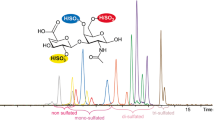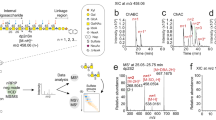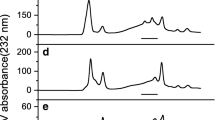Abstract
The relative proportion of L-iduronic acid (IdoA) and D-glucuronic acid (GlcA) is of great importance for the structure–function relationship of chondroitin sulfate (CS)/dermatan sulfate (DS). However, determination of the isotypes of uronic acid residues in CS/DS is still a challenge, due to the instability of free uronic acid released by chemical degradation and its conversion to unsaturated uronic acid by digestion with bacterial eliminase. 1H-Nuclear magnetic resonance (NMR) spectroscopy is a promising tool with which to address this issue, but the traditional method based on the assignment of the ring proton signals of IdoA and GlcA residues still has drawbacks such as the serious overlap of signals in the 1H-NMR spectrum of CS/DS polysaccharides. We found that the proton signals of the N-acetyl group of N-acetyl-D-galactosamines in CS and DS could be clearly distinguished and accurately integrated in the one-dimensional (1D) 1H-NMR spectrum. Based on this finding, here we report a novel, sensitive, and nondestructive 1D 1H-NMR-based method to determine the proportion of IdoA and GlcA residues in CS/DS hybrid chains.



Similar content being viewed by others
Abbreviations
- 1D:
-
one-dimensional
- CSase:
-
chondroitinase
- CS:
-
chondroitin sulfate
- DS:
-
dermatan sulfate
- GalNAc:
-
N-acetyl-D-galactosamine
- GlcA:
-
D-glucuronic acid
- IdoA:
-
L-iduronic acid
- ΔHexA:
-
4-deoxy-L-threo-hex-4-enepyranosyluronic acid
- HPLC:
-
high performance liquid chromatography
- NMR:
-
nuclear magnetic resonance
References
Rodén, L.: Structure and metabolism of connective tissue proteoglycans. In: Lennarz, W.J. (ed.) The Biochemistry of Glycoproteins and Proteoglycans, pp. 267–371. Plenum, New York (1980)
Poole, A.R.: Proteoglycans in health and disease: structures and functions. Biochem. J. 236, 1–14 (1986)
Bandtlow, C.E., Zimmermann, D.R.: Proteoglycans in the developing brain: new conceptual insights for old proteins. Physiol. Rev. 80, 1267–1290 (2000)
Sugahara, K., Kitagawa, H.: Recent advances in the study of the biosynthesis and functions of sulfated glycosaminoglycans. Curr. Opin. Struct. Biol. 10, 518–527 (2000)
Silbert, J.E., Sugumaran, G.: Biosynthesis of chondroitin/dermatan sulfate. IUBMB Life 54, 177–180 (2002)
Sugahara, K., Yamada, S.: Structure and function of oversulfated chondroitin sulfate variants: unique sulfation patterns and neuroregulatory activities. Trends Glycosci. Glycotechnol. 12, 321–349 (2000)
Faissner, A., Clement, A., Lochter, A., Streit, A., Mandl, C., Schachner, M.: Isolation of a neural chondroitin sulfate proteoglycan with neurite outgrowth promoting properties. J. Cell Biol. 126, 783–799 (1994)
Bao, X., Nishimura, S., Mikami, T., Yamada, S., Itoh, N., Sugahara, K.: Chondroitin sulfate/dermatan sulfate hybrid chains from embryonic pig brain, which contain a higher proportion of L-iduronic acid than those from the adult pig brain, exhibit neuritogenic and growth factor-binding activities. J. Biol. Chem. 279, 9765–9776 (2004)
Nandini, C.D., Mikami, T., Ohta, M., Itoh, N., Akiyama-Nambu, F., Sugahara, K.: Structural and functional characterization of oversulfated chondroitin sulfate/dermatan sulfate hybrid chains from the notochord of hagfish: neuritogenic activity and binding activities toward growth factors and neurotrophic factors. J. Biol. Chem. 279, 50799–50809 (2004)
Nandini, C.D., Itoh, N., Sugahara, K.: Novel 70 kDa chondroitin sulfate/dermatan sulfate hybrid chains with a unique heterogenous sulfation pattern from shark skin, which exhibit neuritogenic activity and binding activities for growth factors and neurotrophic factors. J. Biol. Chem. 280, 4058–4069 (2005)
Li, F., Shetty, A.K., Sugahara, K.: Neuritogenic activity of chondroitin/dermatan sulfate hybrid chains of embryonic pig brain and their mimicry from shark liver: involvement of the pleiotrophin and hepatocyte growth factor signaling pathways. J. Biol. Chem. 282, 2956–2966 (2007)
Bao, X., Muramatsu, T., Sugahara, K.: Demonstration of the pleiotrophin-binding oligosaccharide sequences isolated from chondroitin sulfate/dermatan sulfate hybrid chains of embryonic pig brains. J. Biol. Chem. 280, 35318–35328 (2005)
von Holst, A., Sirko, S., Faissner, A.: The unique 473HD-chondroitinsulfate epitope is expressed by radial glia and involved in neural precursor cell proliferation. J. Neurosci 26, 4082–4094 (2006)
Akita, K., von Holst, A., Furukawa, Y., Mikami, T., Sugahara, K., Faissner, A.: Expression of multiple chondroitin/dermatan sulfotransferases in the neurogenic regions of the embryonic and adult CNS suggests that complex chondroitin sulfates function in neural stem cell maintenance. Stem Cells (in press)
Saito, H., Yamagata, T., Suzuki, S.: Enzymatic methods for the determination of small quantities of isomeric chondroitin sulfates. J. Biol. Chem. 243, 1536–1542 (1968)
Yoshida, K., Miyauchi, S., Kikuchi, H., Tawada, A., Tokuyasu, K.: Analysis of unsaturated disaccharides from glycosaminoglycuronan by high-performance liquid chromatography. Anal. Biochem. 177, 327–332 (1989)
Radhakrishnamurthy, B., Berenson, G.S.: Identification of uronic acids in mucopolysaccharides. Arch. Biochem. Biophys. 101, 360–362 (1963)
Fransson, L.Å., Rodén, L., Spach, M.L.: Automated ion-exchange chromatography of uronic acids and uronic acid containing oligosaccharides. Anal. Biochem. 23, 317–330 (1968)
Inoue, S., Miyawaki, M.: Quantitative analysis of iduronic acid and glucuronic acid in sulfated galactosaminoglycuronans by gas chromatography. Anal. Biochem. 65, 164–174 (1975)
Spiro, M.J.: Uronic acid analysis by automated anion exchange chromatography. Anal. Biochem. 82, 348–352 (1977)
Whitfield, D.M., Stojkovski, S., Pang, H., Baptista, J., Sarkar, B.: Diagnostic methods for the determination of iduronic acid in oligosaccharides. Anal. Biochem. 194, 259–267 (1991)
Shaklee, P.N., Conrad, H.E.: The disaccharides formed by deaminative cleavage of N-deacetylated glycosaminoglycans. Biochem. J. 235, 225–236 (1986)
Sudo, M., Sato, K., Chaidedgumjorn, A., Toyoda, H., Toida, T., Imanari, T.: 1H nuclear magnetic resonance spectroscopic analysis for determination of glucuronic and iduronic acids in dermatan sulfate, heparin, and heparan sulfate. Anal. Biochem. 297, 42–51 (2001)
Tabeur, C., Machetto, F., Mallet, J.M., Duchaussoy, P., Petitou, M., Sinaÿ, P.: L-Iduronic acid derivatives as glycosyl donors. Carbohydr. Res. 281, 253–276 (1996)
Yamada, S., Sugahara, K.: Preparation of oligosaccharides from sulfated glycosaminoglycans using bacterial enzymes. In: Thibault, P., Honda, S. (eds.) Capillary Electrophoresis of Carbohydrates (Methods in Molecular Biology, vol. 213), pp. 71–78. Humana, Totowa (2003)
Sugahara, K., Okumura, Y., Yamashina, I.: The Engelbreth–Holm–Swarm mouse tumor produces undersulfated heparan sulfate and oversulfated galactosaminoglycans. Biochem. Biophys. Res. Commun. 162, 189–197 (1989)
Sugahara, K., Tohno-oka, R., Yamada, S., Khoo, K.H., Morris, H.R., Dell, A.: Structural studies on the oligosaccharides isolated from bovine kidney heparan sulphate and characterization of bacterial heparitinases used as substrates. Glycobiology 4, 535–544 (1994)
Sugahara, K., Ohkita, Y., Shibata, Y., Yoshida, K., Ikegami, A.: Structural studies on the hexasaccharide alditols isolated from the carbohydrate- protein linkage region of dermatan sulphate proteoglycans of bovine aorta. Demonstration of iduronic acid-containing components. J. Biol. Chem. 270, 7204–7212 (1995)
Nandini, C.D., Sugahara, K.: Role of the sulfation pattern of chondroitin sulfate in its biological activities in the binding of growth factors. In: Volpi, N. (ed.) Advances in Pharmacology, vol 53, pp. 253–279. Elsevier, Oxford (2006)
Yoshida, K., Arai, M., Kohno, Y., Maeyema, K.I., Myazono, H., Kikuchi, H., Morikawa, K., Tawada, A., Suzuki, S.: Activity of bacterial eliminases towards dermatan sulphates and dermatan sulphate proteoglycan. In: Scott, J.E. (ed.) Dermatan sulfate proteoglycans: chemistry, biology, chemical pathology, pp. 55–80. Portland, London (1993)
Sugahara, K., Mikami, T.: Chondroitin/dermatan sulfate in the central nervous system. Curr. Opin. Struct. Biol. 17, 536–545 (2007)
Acknowledgements
The authors thank X. Bao for the preparation of E-CS/DS. This work was supported by HAITEKU (2004–2008) from the Japan Private School Promotion Foundation, Grant-in-aid for Scientific Research C-19590052 (to S. Y.) and Scientific Research (B) 18390030 (to K. S.) from MEXT (Ministry of Education, Culture, Sports, Science and Technology, Japan), The Human Frontier Science Program RGP0018/2005 (to K. S.), the Core Research for Evolutional Science and Technology (CREST) of the Japan Science and Technology (JST) agency (to K. S.), and a National Project “Knowledge Cluster Initiative” (2nd stage “Sapporo Bio-cluster Bio-S”) from MEXT.
Author information
Authors and Affiliations
Corresponding author
Additional information
The contributions of Fuchuan Li and Shuhei Yamada should be considered equal.
Rights and permissions
About this article
Cite this article
Li, F., Yamada, S., Basappa et al. Determination of iduronic acid and glucuronic acid in sulfated chondroitin/dermatan hybrid chains by 1H-nuclear magnetic resonance spectroscopy. Glycoconj J 25, 603–610 (2008). https://doi.org/10.1007/s10719-008-9124-x
Received:
Revised:
Accepted:
Published:
Issue Date:
DOI: https://doi.org/10.1007/s10719-008-9124-x




